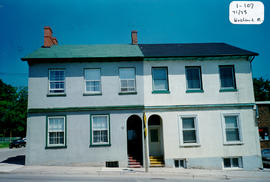The corner building located close to the street (on the north side) at 71 and 73 Holland St. East was built in the Neoclassical Duplex style in 1831. This building was known as the Edmanson Hotel. It is the earliest hotel and possibly the oldest building in Bradford. In this photo (from 1996) it is a residential duplex.
The 71 Holland St. East half was once a boarding place for travellers coming into town by train. These travellers then went on to the surrounding hamlets. There was a garage and shed on Nelson Street. Dave Ogilvie later lived here with his wife (a McKinstry). Their son Gordon was born there in 1911. They eventually moved to the northwest corner of John and Nelson Streets. Butcher George Webb bought it and he and his wife (a Collings) had six children – George, Agatha, Jim, Bertie, Ben and Mary (Mrs. H. Hillary). Mary was still living in the house in 1996.
The 73 Holland St. East half was the home of Jim Webb and his wife Muriel (Houghton). Their son James was in partnership with his father. When Jim died, James took over the butcher shop until he died suddenly. Muriel lived there for a while after that until the house was sold.
The two-storey, six-bay, semi-detached house has a rectangular plan and a shallow-pitched, gable roof with gable end and centre chimneys. The formal façade is symmetrical. Slightly-raised entrances are paired at the centre of the façade and recessed for greater privacy. The entrances have round, arched openings with inset steps and the doors are set into high, rectangular openings and have high transoms. The upper portion of each original, wood-panelled door is glazed. The building has large window openings with low floor to ceiling heights. Large, front windows have high sills that are set into plain, rectangular openings with plain, wood frames and sills. Upper-storey windows are offset from the ground floor. The lower windows were changed in the 1930’s. Those in the west half have multiple panes in the original style. The building has wood frame construction, stucco siding, a parged-stone foundation and a basement. The stucco was added by Len Saint in the 1930’s. The chimney on the west side is original. According to the 2000 inventory, the building is in good condition. (1, 2, 3, 4)


